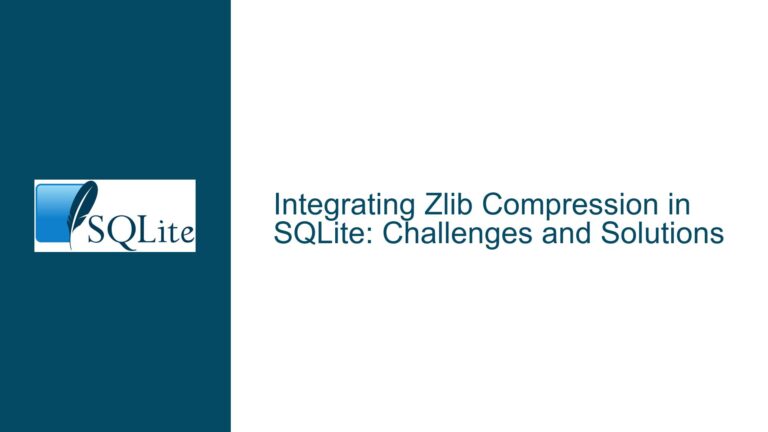Retrieving Last Insert Rowid in SQLite3 WASM: Challenges and Solutions
Understanding the Need for Last Insert Rowid in SQLite3 WASM
When working with SQLite3 in a WebAssembly (WASM) environment, particularly when migrating from WebSQL, one of the critical requirements is to retrieve the last_insert_rowid after executing an INSERT statement. This functionality is essential for maintaining relational integrity, especially in scenarios involving parent-child table relationships. For instance, consider a parent table with an auto-incrementing primary key parent_id and a child1 table that references parent_id. When duplicating a parent record along with its associated child records, the last_insert_rowid is necessary to correctly set the parent_id in the child records.
In the provided scenario, the original WebSQL code uses results.insertId to fetch the last inserted rowid, which is then used to update the parent record and insert corresponding child records. However, when transitioning to SQLite3 WASM, this straightforward approach is not directly available, leading to confusion and the need for alternative methods.
Limitations of the Worker1 API and Promiser Wrapper
The primary challenge in obtaining the last_insert_rowid in SQLite3 WASM stems from the limitations of the Worker1 API and its Promiser wrapper. The Worker1 API is designed to be a lightweight interface for interacting with SQLite3 in a web environment, but it is intentionally limited in functionality. This limitation is explicitly mentioned in the documentation, which describes it as suitable primarily for "toy applications." The API operates by remote-controlling SQLite3 via postMessage(), which inherently restricts access to certain low-level SQLite3 functions, including sqlite3_last_insert_rowid().
The Worker1 API does not provide a direct mechanism to retrieve the last_insert_rowid after an INSERT operation. This is because the API abstracts away much of the underlying SQLite3 functionality, focusing instead on simplicity and ease of use. As a result, developers relying on this API face significant hurdles when attempting to perform more complex operations, such as maintaining relational integrity across multiple tables.
Implementing a Solution: Enhancing the Worker1 API
To address the limitation of the Worker1 API, a new feature was introduced that allows developers to retrieve the last_insert_rowid after executing an INSERT statement. This enhancement involves modifying the exec function to accept a configuration object with a lastInsertRowId property. When this property is set to true, the result object returned by the exec function includes a lastInsertRowId property, which contains the rowid of the last inserted row as a BigInt.
The implementation leverages the sqlite3_last_insert_rowid() function, which is called after the SQL statements are executed. However, it is important to note that this function only returns the rowid of the last INSERT statement executed within the same exec call. If multiple INSERT statements are executed in a single exec call, only the rowid of the final INSERT is returned. This behavior is consistent with SQLite’s native functionality but may require careful consideration when designing complex transactions.
The introduction of this feature provides a more convenient and efficient way to retrieve the last_insert_rowid compared to alternative methods, such as executing a separate SELECT last_insert_rowid() query. The latter approach would require an additional round-trip through the worker, increasing latency and complexity. By integrating the lastInsertRowId property directly into the exec function, the enhanced Worker1 API streamlines the process and reduces overhead.
Practical Considerations and Best Practices
When using the enhanced Worker1 API to retrieve the last_insert_rowid, developers should be aware of several practical considerations. First, the lastInsertRowId property returns a BigInt, which is necessary to accommodate SQLite’s 64-bit integer rowids. However, BigInt values behave slightly differently from standard JavaScript Number values, particularly in terms of arithmetic operations and type coercion. If the application requires the rowid to be treated as a Number, it can be explicitly converted using Number(theRowId). However, this conversion should be done with caution, as it may lead to precision loss for very large rowids.
Another consideration is the timing of the sqlite3_last_insert_rowid() function call. Since this function is called after all SQL statements in the exec call have been executed, it is crucial to ensure that the INSERT statement for which the rowid is needed is the last one executed. If multiple INSERT statements are executed in a single exec call, only the rowid of the final INSERT will be available. To avoid ambiguity, it is recommended to structure the SQL statements such that the INSERT of interest is the last one executed, or to use separate exec calls for each INSERT statement.
Alternative Approaches and Workarounds
While the enhanced Worker1 API provides a convenient solution for retrieving the last_insert_rowid, there are alternative approaches that may be suitable in certain scenarios. One such approach is to use a separate SELECT last_insert_rowid() query after executing the INSERT statement. This method involves an additional round-trip through the worker, which may introduce some latency, but it allows for greater flexibility in cases where multiple INSERT statements are executed in a single transaction.
Another alternative is to use the full-featured SQLite3 WASM API, which provides direct access to all SQLite3 functions, including sqlite3_last_insert_rowid(). This approach requires importing the SQLite3 WASM module directly into the application, either in the main thread or in a worker. While this method offers the most flexibility and control, it also involves a steeper learning curve and may require more extensive modifications to the existing codebase.
Conclusion: Choosing the Right Approach
The choice of approach for retrieving the last_insert_rowid in SQLite3 WASM depends on the specific requirements and constraints of the application. For developers using the Worker1 API, the newly introduced lastInsertRowId property provides a straightforward and efficient solution. However, it is essential to be aware of the limitations and practical considerations associated with this approach, particularly when dealing with multiple INSERT statements or very large rowids.
For more complex scenarios or applications requiring greater flexibility, alternative approaches such as using a separate SELECT last_insert_rowid() query or leveraging the full-featured SQLite3 WASM API may be more appropriate. Ultimately, the decision should be guided by the specific needs of the application, the desired level of control, and the trade-offs between simplicity and functionality.
By understanding the nuances of each approach and carefully considering the implications, developers can effectively manage the retrieval of the last_insert_rowid in SQLite3 WASM, ensuring the integrity and efficiency of their database operations.






